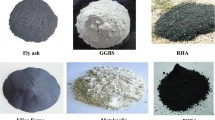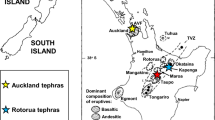Abstract
Ancient mortars used in the construction of the church of Santa María de Irache monastery have been studied. With the aim to characterise their binder and aggregate fractions, a complete characterisation has been carried out including chemical (rapid analysis, soluble salts and trace elements), mineralogical (structural characterisation and X-ray diffraction, XRD) and thermal studies (simultaneous differential thermal and thermogravimetric analysis, DTA-TGA). Lime binder, lime with dolomitic phases and mixed mortars (lime and gypsum) have been determined. The approximate orginal composition of these classes of mortars has been presented. Advice about, the employment of repair materials in a restoration work is given.
Résumé
On a étudié les mortiers employés pour la construction de l'église du monastère de Santa María de Irache. On a réalisé une caractérisation complète ayant pour objet de connaître le liant et le granulat, en utilisant l'analyse chimique (analyse rapide, sels solubles et éléments trace), l'analyse minéralogique (caractérisation structurale et diffractométrie des rayons X, DRX) et des études thermiques (analyse thermique différentielle et thermogravimétrique ATD-ATG). On a établi l'utilisation de mortiers à la chaux aérienne, à la chaux aérienne avec de la dolomite, et de mortiers mixtes (chaux et plâtre). On présente la composition originale de ces types de mortiers. On donne des recommandations pour leur usage dans la restauration du monument.
Similar content being viewed by others
References
Rodríguez-Navarro, C., Hansen, E. and Ginell, W.S., ‘Calcium hydroxide evolution upon aging of lime putty’,J. Am. Ceram. Soc. 81 (11) (1998) 3032–3034.
Moropoulou, A., Theodoraki, A., Bisbikou, K. and Michailidis, M., ‘Restoration synthesis of crushed brick mortars simulating Byzantine lime and material technologies in crete’,Mat. Res. Soc. Symp. Proc. 352 (1995) 759–767.
Proceedings of the International RILEM Workshop, Paisley, Scotland, May 1999, Edited by P. Bartos, C. Groot and J.J. Hughes (RILEM Publications, France).
Alvarez, J.I., Martín, A. and García Casado, P.J., ‘Methodology used in the characterisation of the mortars of Pamplona's Cathedral (Spain)’ [only available in French], in: J. Riederer (Ed.), 8th Congress International on Deterioration and Conservation of Stone, Berlin, 1996, 1457–1470.
Alvarez, J.I., Martín, A., García Casado, P.J., Navarro, I. and Zornoza, A., ‘Methodology and validation of a hot hydrochloric acid attack for the characterisation of ancient mortars’,Cem. Concr. Res. 29 (7) (1999) 1061–1065.
Alvarez, J.I., Navarro, I., Martín, A. and García Casado, P.J., ‘A study of the ancient mortars in the north tower of Pamplona's San Cernin church’,Cem. Concr. Res. 30 (2000) 1413–1419.
Voïnovitch, I.A., ‘Analyse des sols, roches et ciments’ (Ed. Masson, Paris, 1988).
Martín, A. ‘Alteration tests for conservation in stone buildings of Cultural Heritage’ [In Spanish] (Centro de Estudios Ramón Areces, Madrid, 1990).
Kawiak, T., ‘Gypsum mortars from a twelfth-century church in Wislica, Poland”,Stud. Conserv. 36 (1991) 142–150.
Blanco-Varela, M.T., Puertas, F., Macías, A. and Palomo, A., ‘Study of support Roman mortars of Italica's mosaics’, in: J. Delgado Rodrigues, F. Henriques and F. Telmo Jeremias (Eds.), 7th International Congress on Deterioration and Conservation of Stone, Laboratório Nacional de Engenharia Civil, Lisbon, 1992, 1299–1305.
Sarkar, S.L., ‘Microstructural investigation of renaissance mortar from Montreal, Quebec, Canada’,Cem Concr. Res. 22 (1992) 1011–1018.
Marchese, B. and Garzillo, V., ‘An investigation of the mosaics in the cathedral of Salerno: Part I. Characterisation of binding materials’,Stud. Conserv. 28 (1983) 127–132.
Martinet, G., Deloye, F. and Golvin, J.C., ‘Characterisation of the pharaonic mortars of Amon's Temple in Karnak’ [only available in French]Bull. Liaison Lab. Ponts Chaussées 181 (1992) 39–45.
Ashurst, J., ‘Mortars, plasters and renders in conservation’, (Ecclesiastical Architect's and Surveyors' Association, 1983) 16–18.
De la Torre, M.J., Sebastián Pardo, E., Rodríguez-Navarro, C., Martín García, M., Buendía Moreno, A. and Valverde Espinosa, I., ‘A study of building materials used in the Alcazaba of Loja, Granada Spain’ (In Spanish), in: E.M. Sebastián Pardo, I. Valverde Espinosa, U. Zezza (Eds.), III Congreso Internacional de Rehabilitación del Patrimonio Arquitectónico y Edificación, Granada (Spain), 1996, 221–225.
Alvarez, J.I., Navarro, I. and García Casado, P.J., ‘Thermal, mineralogical and chemical studies of the mortars used in the cathedral of Pamplona (Spain)’,Termochim. Acta 365 (2000) 177–187.
De la Torre, M.J., Rodrǵuez, J. and Sebastián, E.M., ‘Geochemical characterisation of Hispanic-muslim mortars and concretes. Origin of the raw materials’ [In Spanish], in: CEDEX (Ed.), IV Congreso de Geoquímica de España, Soria, 1991, 470–478.
Bello, M.A. and Martín, A., ‘Microchemical characterisation of building stone from Seville Cathedral, Spain’,Archaeometry 34 (1) (1992) 21–29.
Borges, C., Caetano, C., Costa Pessoa, J., Figueiredo, M.O., Lourenco, A., Malhoa, M., Gomes, T.P., Silva, J.P. and Veiga, A. ‘Monitoring the removal of soluble salts from ancient tiles by ion chromatography’,J. Chromatogr. A 770 (1997) 195–201.
Alessandrini, G., Bugini, R., Negrotti, R. and Toniolo, L., ‘Characterisation of plasters from the church of San Niccolò di Comelico (Belluno- Nothern Italy)’,Eur. J. Mineral. 3 (1991) 619–627.
Riccardi, M.P., Duminuco, P., Tomasi, C. and Ferloni, P., ‘Thermal microscopic and X-ray diffraction studies on some mortars’,Termochim. Acta 321 (1998) 207–214.
Frizot, M., ‘Mortiers et enduits peints antiques—Étude technique et archéologique’, Université de Dijon (Ed.), Centre de Recherches sur les techniques gréco-romaines, 1975, 57–137.
Webb, T.L. and Krüger, J.E., ‘Carbonates’, in: R.C. Mackenzie (Ed.) ‘Differential Thermal Analysis’ (Academic Press Inc., London, 1970, 303–341).
Bruni, S., Cariati, F., Fermo, P., Pozzi, A. and Toniolo, L., ‘Characterisation of ancient magnesian mortars coming from northern Italy’,Termochim. Acta 321 (1998) 161–165.
Newton, R.G. and Sharp, J.H., ‘The chemical composition of lime plasters’,Cem. Concr. Res. 17 (1987) 77–80.
Hatakeyama, T. and Liu, Z., ‘Handbook of Thermal Analysis’, (John Wiley & Sons Ltd, England, 1998).
Alessandrini, G., Bugini, R., Folli, L., Realini, M. and Toniolo, L., ‘The compositional ratios of mortars. Comparison between chemical and petrographical methods’, in: J. Delgado Rodrigues, F. Henriques, F. Telmo Jeremias (Eds.), 7th International Congress on Deterioration and Conservation of Stone, Laboratório Nacional de Engenharia Civil, Lisbon, 1992, 667–675.
Alessandrini, G., Dassù, G., Bugini, R. and Formica, L., ‘The technical examination and conservation of the portal of St. Aquilino's chapel in the Basilica of St. Lorenzo, Milan’ (In Spanish),Mater. Constr. 39 (213) (1989) 37–45.
Hoffmann, P. and Vetter, G., ‘Analytical examination of mortars from the medieval derelict village Holzeim’,Fresen. J. Anal. Chem. 338 (1990) 133–137.
Lagzdina, S., sedmalis, U., Bidermanis, L., Liepins, J. and Grosvalds, I., ‘Dolomitic lime containing hydraulic additive’,Latvian Journal of Chemistry 3 (1995) 93–98.
Vecchio, S., Laginestra, A., Frezza, A. and Ferragina, C., “The use of thermoanalytical techniques in the characterisation of ancient mortars’,Thermochim. Acta 227 (1993) 215–223.
Author information
Authors and Affiliations
Rights and permissions
About this article
Cite this article
Montoya, C., Lanas, J., Arandigoyen, M. et al. Mineralogical, chemical and thermal characterisations of ancient mortars of the church of Santa María de Irache monastery (Navarra, Spain). Mat. Struct. 37, 433–439 (2004). https://doi.org/10.1007/BF02479640
Received:
Accepted:
Issue Date:
DOI: https://doi.org/10.1007/BF02479640




